Chapter 6: Working at 10,000ft. Above Sea Level
AS TOLD BY JOHN AGERSTEN
CHALLENGES OF LIVING AT 10,000 FT.
Working and living at this altitude has its unique challenges, especially when you first arrive. The oxygen level at this altitude is quite low, and you find that you get out of breath easily. This can also cause “soroche”, the local name for altitude sickness if you push yourself too hard.
On the first trips back and forth from Lima to Tarma with the Lindgrens, we used an oxygen tank that they had in the car if we felt we needed extra oxygen. They rarely used it themselves anymore. After several years in Tarma, they had gotten used to the altitude. The road went several miles across high mountain ranges where the highest pass was 15, 807 ft. above sea level. A little oxygen along the way helped us not feel the effects of the altitude too much. After the second week in Lima, when we had completed our residence permits, and we returned to Tarma, altitude sickness hit me hard! As we arrived at the house in Tarma, without thinking, I grabbed a heavy suitcase in each hand and quickly went up the stairs to the Lindgrens’ second-floor apartment. When I got to the top, it felt like someone had hit me in the head with a sledgehammer. My head was throbbing, and I started vomiting, and eventually also ended up with a fever and diarrhea. All I could do was lie down! Fortunately, it passed after a few days. Little by little, the body got used to the thin air at this altitude. We got some conditioning by going up and down the stairs of the apartment, and eventually, we could walk up pretty quickly, even when we were carrying grocery bags. A few weeks later I could even play soccer with the youth in the congregation.
On the first trips back and forth from Lima to Tarma with the Lindgrens, we used an oxygen tank that they had in the car if we felt we needed extra oxygen. They rarely used it themselves anymore. After several years in Tarma, they had gotten used to the altitude. The road went several miles across high mountain ranges where the highest pass was 15, 807 ft. above sea level. A little oxygen along the way helped us not feel the effects of the altitude too much. After the second week in Lima, when we had completed our residence permits, and we returned to Tarma, altitude sickness hit me hard! As we arrived at the house in Tarma, without thinking, I grabbed a heavy suitcase in each hand and quickly went up the stairs to the Lindgrens’ second-floor apartment. When I got to the top, it felt like someone had hit me in the head with a sledgehammer. My head was throbbing, and I started vomiting, and eventually also ended up with a fever and diarrhea. All I could do was lie down! Fortunately, it passed after a few days. Little by little, the body got used to the thin air at this altitude. We got some conditioning by going up and down the stairs of the apartment, and eventually, we could walk up pretty quickly, even when we were carrying grocery bags. A few weeks later I could even play soccer with the youth in the congregation.
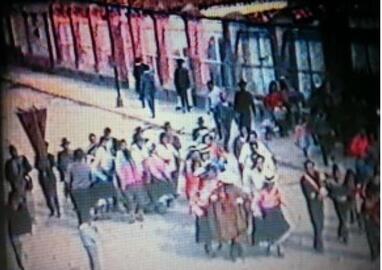
Another thing we learned about the altitude, is that the boiling point of the water was 169 ℉ (as opposed to the “normal” 212℉). Potatoes needed to boil several hours before they were done! We quickly found out that a pressure cooker was a must at this altitude!
There were still many interesting things to learn about the culture and the people in this area, as well. One afternoon we were fascinated by a parade on the road in front of the apartment. It was fun to listen to their music, watch them dance, and look at their instruments and traditional dress.
There were still many interesting things to learn about the culture and the people in this area, as well. One afternoon we were fascinated by a parade on the road in front of the apartment. It was fun to listen to their music, watch them dance, and look at their instruments and traditional dress.
VISITING THE ANDES MINING TOWNS
Morococha and Cerro de Pasco
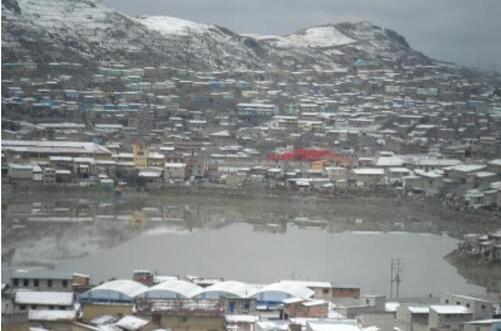
In the first few weeks, we had the pleasure of still being with Lennart and Boyan Lindgren. They gave us a lot of good advice and they showed us around Tarma and the surrounding villages. There were a lot of new things to learn! It was very helpful for us to be able to be together during this time.
Lennart and I did some traveling in their Volvo Duet. Some of the places we visited were high up in the mountains, such as the mining town of Morococha, which was located at an altitude of 14,800 ft. One of the miners was a christian, and he had shared the Gospel with his co-workers. Some started to believe so he began to meet with them in his home. A small revival broke out, and more people were saved. Lennart and I traveled up there, and around 30 friends gathered for a couple of days of bible teaching and conversations. We could see snow on the peaks and it was very cold at night, but we were well dressed where we lay in our sleeping bags.
Lennart and I did some traveling in their Volvo Duet. Some of the places we visited were high up in the mountains, such as the mining town of Morococha, which was located at an altitude of 14,800 ft. One of the miners was a christian, and he had shared the Gospel with his co-workers. Some started to believe so he began to meet with them in his home. A small revival broke out, and more people were saved. Lennart and I traveled up there, and around 30 friends gathered for a couple of days of bible teaching and conversations. We could see snow on the peaks and it was very cold at night, but we were well dressed where we lay in our sleeping bags.
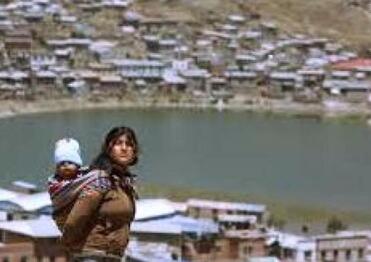
We also visited Cerro de Pasco, a town located at 14,000 ft. above sea level. It is an old town that is a center for large mines around the area. The Spaniards began silver mining here as early as the 17th century, and In the 1800s, the mines here were the largest producers of silver in Peru. Copper, gold, zinc, and other minerals also come out of these mines. In the 1800s, the English, who were heavily involved in the mining, built a railway from Lima to Cerro de Pasco, a distance of about 300 miles over high mountains and valleys. A number of tunnels and bridges were needed to transport the valuable ore down to the coast. The railway is still in use to this day. When we arrived in Tarma, the mines were still controlled by foreign companies.
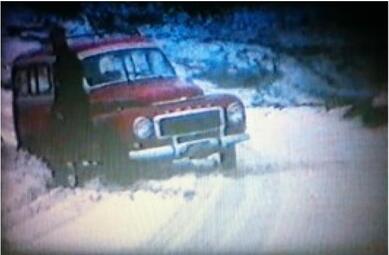
Lennart and I drove the three hours from Tarma to Cerro de Pasco to visit a group of believers there who had invited us. We went to the town square and sold Bibles and Christian literature. We also held an open-air meeting and many people stopped to listen or talk. In the evening we held a service in their church room. From there, we drove on to a smaller mining community where some Christian workers had invited us to visit them. We had to cross a high pass with the car. The weather was gray and what was rain further down in the valley, came as snow at this altitude. The snow accumulated on the road, up to 4” in several places! This was not fun since we just had summer tires! But we made it, although not without difficulty! But it was worth it because God poured out His blessing on the services, and many heard the word of God.
La Oroya, one of the mining towns on the Lima - Tarma road, had a fairly large hospital that was run by the mining company there. It employed both foreign and Peruvian doctors. Per Anderås introduced us to the German chief physician there, and he proved a great contact to have. We were offered the same free medical care and treatment there that Anderås and Lindgren also received.
La Oroya, one of the mining towns on the Lima - Tarma road, had a fairly large hospital that was run by the mining company there. It employed both foreign and Peruvian doctors. Per Anderås introduced us to the German chief physician there, and he proved a great contact to have. We were offered the same free medical care and treatment there that Anderås and Lindgren also received.
TRAVELING TO THE RAINFOREST AREAS IN THE EAST
Villa Dorada
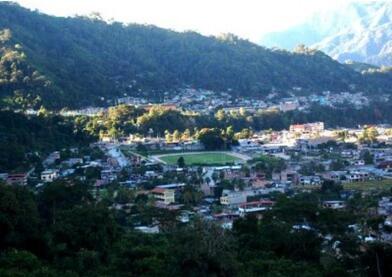
Another trip Lennart and I made went In another direction: east down the valley to the jungle. Per Anderås and two Peruvian evangelists were also with us on this journey
After about a two hour drive we reached the small town of La Merced. The town lies at a fairly low altitude (2460 ft. above sea level) and is a beautiful sight surrounded by jungle-covered hills with coffee plantations and farms cultivating tropical fruit, and with the river flowing below it in the valley. The temperature is at 75 to 80℉ and it often goes higher than that during the day.
We were meeting the owner of a fairly large coffee plantation in the village of Villa Dorada near La Merced. He was the one who had invited us and arranged for some Bible study days there. We had to wait for him for a while, but finally, he showed up in his jeep. It was a rebuilt military jeep from 1942.
After about a two hour drive we reached the small town of La Merced. The town lies at a fairly low altitude (2460 ft. above sea level) and is a beautiful sight surrounded by jungle-covered hills with coffee plantations and farms cultivating tropical fruit, and with the river flowing below it in the valley. The temperature is at 75 to 80℉ and it often goes higher than that during the day.
We were meeting the owner of a fairly large coffee plantation in the village of Villa Dorada near La Merced. He was the one who had invited us and arranged for some Bible study days there. We had to wait for him for a while, but finally, he showed up in his jeep. It was a rebuilt military jeep from 1942.
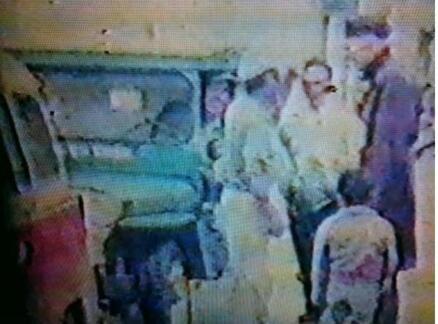
We would continue our trip in this vehicle because the road ahead was too bad even for Lennart’s Volvo Duet. We loaded our cases in the bed in the back of the Jeep. Two of us fit on the seat inside with the driver, but the other three of us had to sit in the back of the jeep surrounded by boxes, suitcases, spare tires, and much more.
The photo is not the best, but you can see the Jeep behind the red Volvo, and Lennart, in full rain gear, speaking to the owner of the Jeep.
We had barely traveled about a hundred yards when the driver said that there was something wrong with the gearbox. He was not able to shift gears. There was nothing for it but stop and try to repair it. The gearbox was taken out. After a lot of work, we finally got it fixed, and the journey could continue. First, we had to cross a narrow suspension bridge over a gorge. That was kind of scary because the bridge rocked something terrible! A little later we had to cross a river where the water reached up to the middle of the tires. Then we began the ascent to a steep hill.
The photo is not the best, but you can see the Jeep behind the red Volvo, and Lennart, in full rain gear, speaking to the owner of the Jeep.
We had barely traveled about a hundred yards when the driver said that there was something wrong with the gearbox. He was not able to shift gears. There was nothing for it but stop and try to repair it. The gearbox was taken out. After a lot of work, we finally got it fixed, and the journey could continue. First, we had to cross a narrow suspension bridge over a gorge. That was kind of scary because the bridge rocked something terrible! A little later we had to cross a river where the water reached up to the middle of the tires. Then we began the ascent to a steep hill.
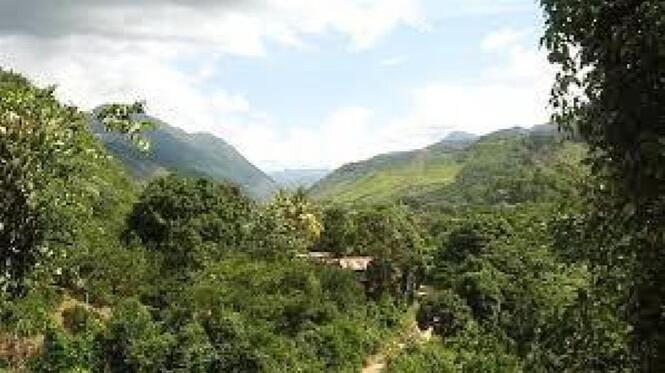
The road we were driving on could hardly be called a road; it was more like a path. It wrapped itself around the steep cliffs and was so narrow that the Jeep barely fit. The tires scraped along the rock wall on one side and seemed to be hanging out on the edge of the precipice on the other. It had rained a lot the days before so the road was muddy and slippery. Those of us sitting on the back bed had to hang on for dear life the whole time! In several places, we had to lean over and hang on to the side of the car to act as a counterweight so we wouldn’t tip over. It was quite an experience! Since then we have ridden on many miserable and steep roads, but since we were new in Peru, this trip made an extra big impression. After driving at a snail's pace for just over three hours, we came to a ledge, and far below us, we saw La Merced lying beautifully framed by green and lush jungle. Large areas were planted with orange trees. After another forty-five minutes, we arrived at Villa Dorada. We were greeted by a group of believers gathered from all over the area around the small village. Some had walked for two days in the hilly terrain to participate in the Bible and prayer days. We were treated to food and pleasant conversation before the plantation owner took us to the village hotel. It was the largest house on the site, with a shop on the ground floor and rooms on the second. The roof was just corrugated metal above us. There were a couple of open windows in the room and there was an opening between the ceiling and the walls so that air, but also mosquitoes and other insects could fly straight in. The room was not furnished, but we had air mattresses and sleeping bags. The missionaries Lennart and Per were already familiar with the conditions we would encounter out in the villages both in the mountains and in the jungle, so we came prepared.
When it was almost time for the services to begin, we went up to the newly built church. It consisted of a framework of logs with the roofs and walls made of sheet metal. Wooden benches sat on the dirt floor, and the dirt floor was so newly laid that the benches were sinking into it. This caused the benches to constantly tilt, so we felt almost like we were sitting on a swing! They had just bought a light fixture but it was not installed yet. They wanted us to help with that. That took some time, but finally, we had a pair of solitary light bulbs hanging down from the ceiling. In the meantime, more people were arriving, both believers and others who wanted to attend the service. Then somebody decided that we had to eat first, so It was past ten in the evening before the service could actually begin!
The next day, the first service started at 6 in the morning. It continued all day and was only interrupted for communal meals. We continued the same program for three days. The fellowship was wonderful, and more people were saved. The Bible study was quite an experience for me who was new. The Bible knowledge of most of those present was very poor, both because they were quite new in the faith, but also because many could not read or write. They asked many kinds of questions, even about what I considered the most elementary things. The Catholic Church held Mass but gave no instruction. At that time, any Bible reading there was, was read in Latin that no one understood. Many in these areas had rarely been to a Catholic church in any case. Now several wanted to be baptized, and it was decided that two of the evangelists would stay and hold a baptismal service the following afternoon.
So we said goodbye to our new dear friends. The way home went faster as the road was now drier and better. It was a pleasure to sit in the Volvo after three hours on the shaky bed of the Jeep and drive home to Tarma where we were meeting in the church that night. The road to Tarma which is quite challenging, narrow, and winding with steep cliffs in places, now felt like a great highway after driving on the road to Villa Dorada!
We visited Villa Dorada and other places down in the jungle and also the villages in the mountains several more times later for services, baptisms, and Bible Study weeks. It became normal to get out long johns and undershirts with long sleeves, woolen sweaters, hats, and boots to go visit the mining communities, while the journeys to the places down the valley required light clothes and swimming trunks. We also became used to traveling between places with large altitude differences. It’s a blessing that our bodies are created to adapt quickly. Still, we rarely managed the trip between Lima and Tarma over Ticlio without the headaches and a feeling of heaviness when we arrived. But we did not need to use oxygen on these trips after having lived in Tarma for a few months.
When it was almost time for the services to begin, we went up to the newly built church. It consisted of a framework of logs with the roofs and walls made of sheet metal. Wooden benches sat on the dirt floor, and the dirt floor was so newly laid that the benches were sinking into it. This caused the benches to constantly tilt, so we felt almost like we were sitting on a swing! They had just bought a light fixture but it was not installed yet. They wanted us to help with that. That took some time, but finally, we had a pair of solitary light bulbs hanging down from the ceiling. In the meantime, more people were arriving, both believers and others who wanted to attend the service. Then somebody decided that we had to eat first, so It was past ten in the evening before the service could actually begin!
The next day, the first service started at 6 in the morning. It continued all day and was only interrupted for communal meals. We continued the same program for three days. The fellowship was wonderful, and more people were saved. The Bible study was quite an experience for me who was new. The Bible knowledge of most of those present was very poor, both because they were quite new in the faith, but also because many could not read or write. They asked many kinds of questions, even about what I considered the most elementary things. The Catholic Church held Mass but gave no instruction. At that time, any Bible reading there was, was read in Latin that no one understood. Many in these areas had rarely been to a Catholic church in any case. Now several wanted to be baptized, and it was decided that two of the evangelists would stay and hold a baptismal service the following afternoon.
So we said goodbye to our new dear friends. The way home went faster as the road was now drier and better. It was a pleasure to sit in the Volvo after three hours on the shaky bed of the Jeep and drive home to Tarma where we were meeting in the church that night. The road to Tarma which is quite challenging, narrow, and winding with steep cliffs in places, now felt like a great highway after driving on the road to Villa Dorada!
We visited Villa Dorada and other places down in the jungle and also the villages in the mountains several more times later for services, baptisms, and Bible Study weeks. It became normal to get out long johns and undershirts with long sleeves, woolen sweaters, hats, and boots to go visit the mining communities, while the journeys to the places down the valley required light clothes and swimming trunks. We also became used to traveling between places with large altitude differences. It’s a blessing that our bodies are created to adapt quickly. Still, we rarely managed the trip between Lima and Tarma over Ticlio without the headaches and a feeling of heaviness when we arrived. But we did not need to use oxygen on these trips after having lived in Tarma for a few months.